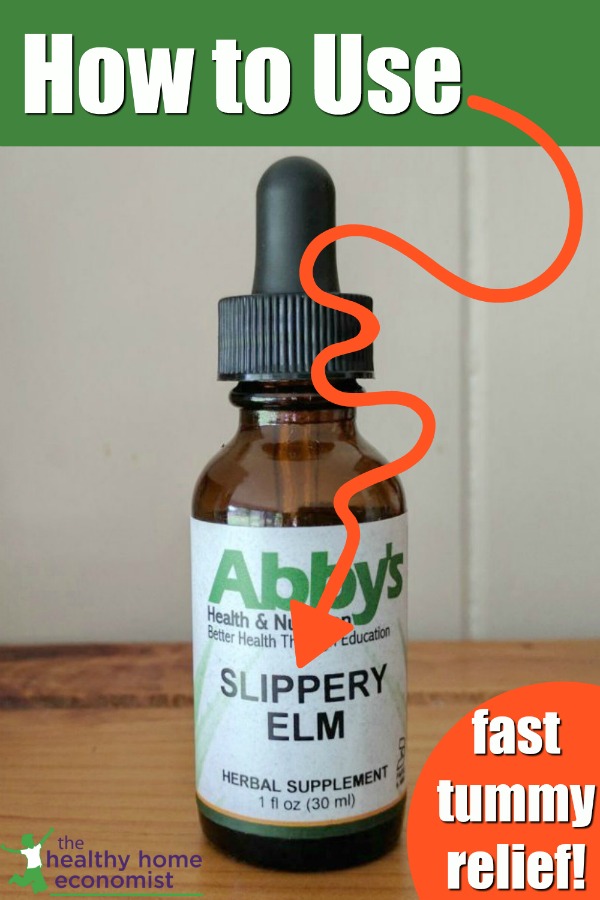Table of Contents[Hide][Show]
How to use the herb slippery elm for quick, soothing relief from a variety of gastrointestinal complaints such as pain and bloating.

This time of year, tummy aches and stomach bugs seem to run rampant through any group of people where kids are involved! This is a prime situation to make full use of the many benefits of slippery elm.
When someone in my family has a stomach ache or is experiencing any sort of digestive distress (from perhaps eating out or too many sweets at a party), slippery elm is by far my favorite astringent medicinal herb (besides bitters) to use as a soothing tonic.
Slippery elm is an herb native to North America and is derived from the inner bark of the elm tree. It has long been used by traditional cultures in the New World for a variety of ailments, but its use as a digestive aid is probably the most popular.
The benefits of slippery elm for soothing the entire digestive tract are many as it forms a soothing film over any mucous membrane it comes into contact with.
Not that this matters much (to me at least), but the FDA has even approved slippery elm as a safe, demulcent substance, which means that it relieves minor pain and inflammation in mucous membranes such as what lines the digestive system. (1)
The ability to temporarily reduce inflammation and pain makes the benefits of slippery elm especially helpful for conditions such as IBS and colitis. It can also soften and add bulk to stools, so it is useful for both diarrhea and constipation issues.
Its soothing/coating qualities protect the throat and so can be helpful for persistent reflux problems as well. Even folks with ulcers and gastritis can enjoy the benefits of slippery elm.
Benefits of Slippery Elm
I have found that the most effective way to utilize the benefits of slippery elm is as a tincture. You can make the herbal tincture yourself or purchase it locally and online. Alternatively, the herb is available in pill or powder form.
Used as a tincture, it easily coats all mucous membranes from the mouth right through to the rectum as it passes through the body.
It is slightly sweet, so taking it with a swallow or two of water tastes great!
This is a good remedy to take with you when you travel.
It keeps tummy aches at bay from the anxiety that can occur from a disrupted routine and mitigates intestinal problems when the quality of the food is lower than what you would enjoy at home.
Dosage
My kids ask for it anytime they feel the need. It can safely be used up to 3 times per day. Use 28-56 drops in some water each time is what my bottle says. Always follow the directions on whatever brand you buy, of course.
Truthfully, I’ve found that you don’t need anywhere near 28-36 drops per dose. I give myself or my family maybe 10-15 drops in an ounce or so of water and that typically works fine the very first time. I occasionally need to give another dose a few hours later, but most of the time, one dose works wonders!
How to Choose a Brand
The next time you are at the health food store, pick up a bottle of Slippery Elm tincture (this brand suggested) that is vetted as sustainably grown and harvested.
Keep it in your wellness cabinet with your other herbs and whole food supplements.
Contraindications
Please note that the slippery elm benefits cannot be enjoyed during pregnancy. It has the potential to dilate the cervix and/or stimulate uterine contractions.
Check with your practitioner before using it during breastfeeding. In some situations, it can be used safely.

References
(1) Ulmus rubra
(2) The Long, Hollow Tube: A Primer on the Digestive System
More Information
Rice Water as Gastrointestinal Remedy
The Best Herb for Candida Overgrowth
Best 3 Fertility Herbs
Food Poisoning Remedies
Safe, Nontoxic Gas Remedy for Babies
Are You a Tummy Bug Magnet?








I use this all the time!
I wonder if anyone had tried using it for morning sickness?
Love, love, love slippery elm!
In powder form slippery elm is a hit mixed with maple syrup and rolled into one inch balls. My 10 yr old son struggles with eczema and before we knew to change the diet we had him eat one ball per day to try to fix the leaky gut. No complaints and we did see jimprovement even with just that. Just thought I’d mention it in case someone already had powder on hand and was looking for an easy delivery system .
Thanks for sharing this information to us. Actually, this is just my first time to hear this slippery elm. It’s glad to know that this herb is also good for digestive relief. Very helpful!
I’m travelling to Egypt and Jordan next month. Do you have any other pointers on herbal remedies that might be good to take along? Definately taking some Slippery Elm.
I’ve always used peppermint for tummy issues including gas pains and digestion problems. I’ll check out this herb, also! For herbs and remedies, check out http://www.bulkherbstore.com- you can also make your own tinctures 🙂
Thanks,
Melissa
Hi Alison, I have used slippery elm myself while breastfeeding. It is a very mild herb.
My absolute FAVORITE book for herbs during pregnancy/lactation is Wise Woman Herbal for the Childbearing Year. It is awesome. I used it extensively for all 3 of my pregnancies. Here is a link to it:
I wholeheartedly agree. That is an awesome book.
I adore your blog, and as a sustainably-minded herbalist who frequently convenes with other herbalists from all over the U.S. (conventions, blogs, workshops), I want to share that slippery elm has been an herb we don’t suggest anymore for general use due to its endangered speciesstatus. (due to unsustainable, large-scale harvesting and dutch elm disease issues) We save it for people who need it very specifically and desperately (wasting diseases, etc.) and definitely don’t promote it anymore as a general-use herb for minor issues, because so many other herbs that are abundant may be substituted.
Rosemary Gladstar, one of the foremost herbalists in the US, started United Plant Savers, a non-profit organization to educate people about these kinds of issues, and more information can be found there.
Marshmallow root is a fine mucilaginous alternative to slippery elm. Slippery elm has its place, but once you find out more about this issue, please consider adding something to your s. elm blog post alerting readers about this issue, and that they should strive to be 100% certain that their supplier harvests sustainably, or learn to do it themselves. That way, we’ll have slippery elm in the future when we really need it.
When harvesting any surviving trees you may find or grow yourself, use bark from the largest branches. Cutting too much of the main trunk may kill this beautiful tree that has been rapidly vanishing for the last few decades.
Note: neither link below is for profit or personal gain
United Plant Savers Link for Herbal Sustainability:
Here’s an informative post from an Edible and Medicinal Plant Forum about this issue entitled, “Save our Slippery Elm”:
And a final source of information is herbalist Henritte Kress’s site for herbal education (again, not for profit):
http://www.henriettesherbal.com/archives/best/2003/slippery-elm.html
Thanks so much for listening.
Meg
Meg, thank you for this important information. I will add to the post to make sure the source is sustainable for whatever folks end up buying.
Thanks, Sarah! The trees thank you, not to mention all the botanists/herbalists/environmentalists who’ve been working so hard on this education campaign. 🙂
For me I would have no idea what ‘sustainable harvesting’ means. Just putting that out there…might need to come with what questions to ask, what to look for, oh and what it means? LOL